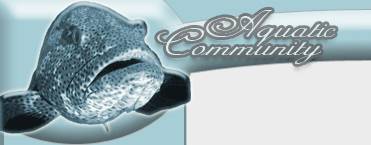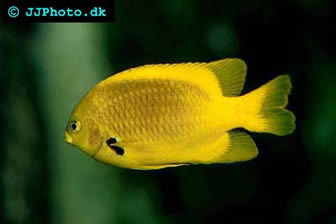Herald's Angelfish
Centropyge heraldi
The fish species Centropyge heraldi is known under several different names in English, including Herald's angelfish, Golden angelfish, Yellow angelfish, Yellow pygmy angelfish, and False lemonpeel angelfish.
Centropyge heraldi has not been evaluated for the IUCN Red List of Threatened Species.
Geographical range, habitat and habits
Herald's angelfish is found in the Pacific Ocean, from Taiwan (China) to the Tuamotu Archipelago (French Polynesia). The northern border of the range is located in southern Japan, while the southernmost specimens inhabit the Great Barrier Reef. This fish is very common around the islands of the Central Pacific, but fairly rare in Australian and New Guinean waters.
Herald's angelfish typically inhabits steep outer reef slopes, but the species is occasionally found on lagoon reefs as well. Its depth range is 5-90 meters / 16-295 feet. It lives in pairs or small harems consisting of 2-4 individuals.
Size and appearance
The largest scientifically measured Herald's angelfish was 10.0 cm / 3.9 in.
This fish is bright yellow or bright orange. Behind the eye you can see a dusky olive coloured patch with yellow spots.
Herald's angelfish looks very similar to the Lemonpeel angelfish, Centropyge flavissimus, but does not have a blue ring around the eye and gill cover. (Another difference is that Herald's angelfish isn’t as dependant on algae as the Lemonpeel angelfish. The Lemonpeel angelfish is typically easier to find in fish stores and less expensive than Herald's angelfish.)
Herald's Angelfish care
Herald's angelfish is generally a peaceful creature, but it should not be combined with other species of dwarf angelfish. A 55 gallons / 200 litre aquarium is large enough for a single specimen, while a 75 gallon / 285 litre aquarium or larger is recommended if you wish to house a pair.
The aquarium must include suitable hiding spots as well as plenty of room for swimming. Include live rock in the set-up and encourage natural algae growth since this makes it possible for the fish to carry out its natural feeding behaviour.
Herald's angelfish is considered reef safe with caution. It is important to keep it well fed.
A water temperature of 72-78° F / 22-25.5° C is recommended when keeping Herald's angelfish. The specific gravity should be in the 1.020-1.025 range and the pH-value at 8.1-8.4. A high water quality is important.
Feeding Herald's Angelfish
Herald's angelfish is a predominantly herbivorous species that feed on algae in the wild, but it will also ingest tiny animals that live among the algae. Algae and algae based foods should be the staple food in the aquarium, but occasional servings of meaty foods like mysid shrimp and brine shrimp are also important. Keep the diet varied, e.g. by serving various types of fresh and dried marine algae, spirulina, algae based flakes/pellets, and angelfish formula.
Breeding Herald's Angelfish
In the wild, Herald's angelfish form harems consisting of 2-4 individuals. A male-female pair can be housed in a 75 gallon / 285 litre aquarium. Little is known about the breeding behaviour of Herald's angelfish, but harem formation with sex inversion is common among the species belonging to the genus Centropyge.
Marine Angelfish Articles:
African Flameback Angelfish – Centropyge acanthops
Asfur Angelfish – Pomacanthus asfur
Bicolor Angelfish – Centropyge bicolor
Blueface Angelfish – Pomacanthus xanthometopon
Cherub Angelfish – Centropyge argi
Coral Beauty – Centropyge bispinosa
Emperor Angelfish – Pomacanthus imperator
Flame Angelfish – Centropyge loricula
French Angelfish – Pomacanthus paru
Koran Angelfish – Pomacanthus semicirculatus
Lamarck's Angelfish – Genicanthus lamarack
Potter's Angelfish – Centropyge potteri
Queen Angelfish – Holacanthus ciliaris
Regal Angelfish – Pygoplites diacanthus
Rock Beauty Angelfish – Holacanthus tricolor
Rusty Angelfish – Centropyge ferrugata
Watanabe's Angelfish – Genicanthus watanabei

